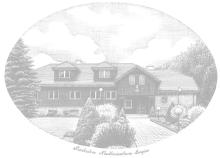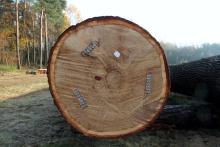 Asset Publisher
Asset Publisher
Polish forests
Poland is in the European lead, while concerning the area of all forests. They cover about 29,2 % of the country territory, and grow within the area of 9,1 million hectares. The overwhelming majority of the forests is state owned, of which almost 7,6 million hectares are managed by the State Forests National Forest Holding..
The number of Polish forest is still growing. The forestation rate of the country has increased from 21 % in 1945 to 29,2 % at the moment. Between 1995 and 2008, the forest area increased by 310 thousand ha. The basis for afforestation works is the "National Programme for Increasing the Forest Cover" (KPZL), assuming an increase of the forestation rate up to 30 % by 2020 and up to 33 % by 2050. Polish forests abound in flora, fauna and fungi. 65 % of the total number of animal species live there.
The forests grow in our country on poor soils, mainly because of the development of the agriculture in previous years. It influences the distribution of the types of the forest sites in Poland. Over 55 % of the forest areas is covered with coniferous forests. In other areas, there are forest sites, mainly the mixed ones. Their small part constitute alder and riparian forests – not more than 3 %.
In the years 1945 – 2011 the area of natural deciduous tree stands within the area of the State Forests National Forest Holding increased from 13 to 28,2 %.
Within the lowlands and uplands the most often occurring tee species is pine. It covers 64,3 % of the forest area of the State Forests National Forest Holding and 57,7 % of private and commune forests. In the mountains the predominant species is European spruce ( in the west) and European spruce with beech (in the east). Domination of pine is the result of carrying on sustainable forest management in the past. Once, the monocultures (crops or cultivations of one species) were the answer to the great demand of industry for wood. Such forests appeared to be quite fragile to climatic factors. They also were often the prey of pests' expansion.
In Polish forests, the share of other tree species, especially deciduous trees have been systematically increasing. The foresters have stepped aside from monocultures – that is why, they try to fit specific species of the forest stand to the natural stand, that would be proper for the given area. Thanks to that, in the years 1945 – 2011, the area of the deciduous tree stands within the lands of the State Forests National Forest Holding increased from 13 to 28,2 %. There occur more and more frequently the following tree species: oaks, ashes, maples, sycamore maples, elms, but also birches, beeches, alders, poplars, hornbeams, aspens, tilias and willows.
Our forests are the most often represented by the forest stands aged 40 to 80 years. The average age of the forest equals 60 years. More and more trees are of big size at the age over 80 years. Since the end of the Second World War, the forests' area has increased up to almost 1,85 million hectares.
Raport o stanie lasów w Polsce 2012
 Asset Publisher
Asset Publisher
Dni Ochrony Środowiska 2019
Dni Ochrony Środowiska 2019
Kolejne wielkie święto wszystkich miłośników przyrody
23 czerwca zapraszamy do Łazienek Królewskich w Warszawie na drugą edycję pikniku edukacyjnego Dni Ochrony Środowiska, objętego Patronatem Honorowym Prezydenta Rzeczypospolitej Polskiej Andrzeja Dudy. Piknik stanowi warsztatową część konferencji „Dla Lasu, Dla Ludzi - Leśnictwo XXI wieku w odpowiedzi na oczekiwania społeczeństwa w zakresie edukacji ekologicznej”. Obchodząc 95-lecie Lasów Państwowych chcemy przypomnieć, że Polska to również zachwycające krajobrazy, niezwykłe bogactwo przyrodnicze, swoboda dostępu do lasów oraz silny i emocjonalny związek ludzi z naturą.
Mamy co wspólnie świętować!
W niedzielę 23 czerwca na terenie rekreacyjnym Muzeum Łazienki Królewskie w Warszawie (wejście od ul. Myśliwieckiej przy Parku Agrykola) od godz. 10.30 do 18.00 odbędzie się wielki, edukacyjny piknik rodzinny. Przy blisko 30 stanowiskach wystawców z całej Polski będzie można wziąć udział w warsztatach eko-stolarki, zobaczyć pokazy sokolnicze i kynologiczne, wysłuchać prelekcji o leśnym survivalu i bezpiecznym grzybobraniu, poznać tajniki pracy leśników, strażaków i policjantów oraz spróbować darów lasu, wziąć udział w konkursach i quizach wiedzy o przyrodzie, a także „poczuć” las wszystkimi zmysłami. Czekamy na rodziny z dziećmi oraz wszystkich miłośników lasów i przyrody.
W tym roku udział w wydarzeniu wezmą także nadleśnictwa Leśnego Kompleksu Promocyjnego „Puszcza Świętokrzyska”: Daleszyce, Kielce, Łagów, Skarżysko, Suchedniów i Zagnańsk oraz Nadleśnictwo Stąporków. Wraz z leśnikami z Regionalnej Dyrekcji Lasów Państwowych w Radomiu przedstawią zagadnienia dotyczące pszczelarstwa i bartnictwa – działanie Pszczoły wracają do lasu w ramach projektu rozwojowego Zdrowa Żywność z Polskich Lasów. Opowiedzą o projektach Lasów Państwowych dotyczących ochrony siedlisk i gatunków, małej retencji nizinnej, ochrony popielicowatych na terenie Puszczy Świętokrzyskiej, darów świętokrzyskich lasów. Będą opowiadali jak wiele ma zastosowań i jak przyjazne dla człowieka i środowiska jest drewno. Będzie też o zrównoważonej, wielofunkcyjnej gospodarce leśnej z uwzględnieniem problemów z kornikiem ostrozębnym i kornikami jodłowymi. Leśnicy pokażą jak wyglądają budki legowe dla ptaków, schrony dla nietoperzy i skrzynki dla popielicowatych i jakie gatunki je zasiedlają. Nie zabraknie też informacji na temat projektu ochrony, promocji i zachowania pomnika przyrody dąb Bartek, akcji „Czas w las” w ramach kampanii Dla Lasu Dla Ludzi. A dla spragnionych widoku lasu będzie do obejrzenia Las w słoiku.
Zapraszają:
Ministerstwo Środowiska
Państwowe Gospodarstwo Leśne Lasy Państwowe
Muzeum Łazienki Królewskie w Warszawie
Narodowy Fundusz Ochrony Środowiska i Gospodarki Wodnej
Szczegółowych informacji udziela Centrum Informacyjne Lasów Państwowych:
Warszawa, ul. Grójecka 127, tel. 22 185 53 53, cilp@cilp.lasy.gov.pl
Termin
23 czerwca godz. 10:30
23 czerwca godz. 18:00
Lokalizacja
Muzeum Łazienki Królewskie; wejście od ul. Myśliwieckiej przy Parku Agrykola


 fot. Paweł Fabijański
fot. Paweł Fabijański
 fot. Paweł Fabijański
fot. Paweł Fabijański
 fot. Paweł Fabijański
fot. Paweł Fabijański



